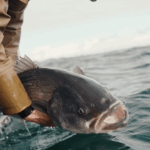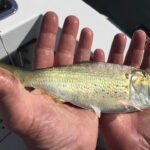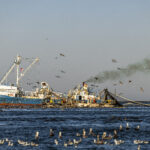
Release Mortality Revisited: New Research from Massachusetts DMF
Feature Photo Credit: Robbie Tartaglia What’s going on? For decades, striped bass management relied on a

March 5, 2021
Emilie Franke
Fishery Management Plan Coordinator
Atlantic States Marine Fisheries Commission
1050 North Highland Street, Suite 200A-N
Arlington, Virginia 22201
Dear Ms. Franke and members of the ASMFC Atlantic Striped Bass Management Board:
Thank you for the opportunity to comment on the Public Information Document (PID) for Amendment 7 to the Interstate Fishery Management Plan (FMP) for Atlantic striped bass.
The American Saltwater Guides Association (ASGA) is a coalition of recreational fishing guides, small businesses, and conservation-minded anglers who find greater value in long-term stock abundance rather than simply maximizing harvest. We are committed to the concept of “better business through conservation,” reflecting our belief that a precautionary approach to fisheries management based on the best available science provides higher-quality fishing opportunities that bolster the recreational fishing economy. Atlantic striped bass, far and away the most commonly recreationally targeted species under ASMFC’s jurisdiction,[1] embodies this philosophy. The outlook for our businesses hinges on a robust population of this iconic species from Maine to North Carolina, and with spawning stock biomass at a 25-year low,[2] the future is uncertain.
In principle, we are concerned with the initiation of a comprehensive amendment process when the striped bass fishery has far more urgent needs. The stock was declared overfished nearly two years ago, and while the Atlantic Striped Bass Management Board (hereafter referred to as the Striped Bass Board) took action to end overfishing through Addendum VI,[3] there has not yet been any discussion of a rebuilding plan, despite Amendment 6’s own requirement that the stock be rebuilt within 10 years of being declared overfished.[4] Due to data uncertainties associated with the COVID-19 pandemic, it is uncertain whether Addendum VI’s provisions were successful in curbing fishing mortality and putting the stock on a path to eventual recovery. Furthermore, some of the specific potential issues to be included in the amendment, such as Regional Management (Issue 5) and Recreational Release Mortality (Issue 7) are being considered for public input even as fisheries scientists are in the midst of research and modeling efforts to inform these issues.
All of this being said, we are aware that it is the will of the Striped Bass Board to move ahead with this amendment, and below we provide our thoughts on each of the issues presented in the PID.
Issue 1: Goals and Objectives
We believe that the current goal and objectives of the Atlantic Striped Bass FMP, as stated in Amendment 6, continue to be appropriate for striped bass management. A robust spawning stock characterized by a broad age structure is critical for reducing recruitment variability for a species whose spawning success largely depends on favorable environmental conditions.[5] Such a diversity of age classes promotes long-term stock health and stability, which in turn supports the health and stability of commercial and recreational fisheries. Such stock stability is a first-order concern, far more important to our coastal fisheries than management stability or flexibility.
Given the suitability of the current goal and objectives for striped bass management, we recommend that this issue be removed from further consideration for inclusion in Amendment 7. We believe that the goal and objectives are not the problem, but instead the fact that the Striped Bass Board has not adhered to them in its actions over the past decade.
Issue 2: Biological Reference Points
Before addressing this issue, we first want to express our disappointment with the Striped Bass Board’s inclusion of the following sentence on page 7 of the PID: “Given the 2018 benchmark assessment found overfishing was occurring and the SSB was below the target even during those years that the striped bass population was at a historically high level, the current reference points may be unattainable given current objectives for fishery performance.” This sentence is editorial in nature, is based on speculation rather than science, and is fundamentally misleading to members of the public without a background in fisheries science who depend on the PID to provide a transparent and neutral accounting of the issues that are up for consideration.
With regard to the issue of Biological Reference Points, ASGA supports the best available science, but recognizes that due to the absence of a stock-recruitment relationship and the fact that model-based reference points are not available, we must instead consider “empirical” reference points based on a given year. We continue to believe that 1995 is an appropriate reference year given the abundance and broad age structure of the striped bass population at that time, in accordance with Amendment 6’s goal and objectives. Contrary to the editorial comment in the PID, the most recent stock assessment’s finding that overfishing was occurring even when the stock was at this high level suggests that if fishing mortality is controlled, we may well be able to achieve the current target level (125% of 1995 spawning stock biomass). While some have criticized the 1995 reference points as arbitrary, any other reference points selected now, in the absence of model-derived reference points, would also be arbitrary. The rationale for using 1993 as a potential alternative reference year (with lower threshold and target values) “because SSB was lower than in 1995 but still produced a strong year-class” is flawed given the lack of a stock-recruitment relationship for striped bass unless the stock is at very low levels. We believe that 1995 remains an appropriate reference year, and recommend that the Biological Reference Points remain unchanged and that this issue be removed from further consideration in Amendment 7. The fact that the Striped Bass Board has failed to maintain a healthy striped bass stock is not a suitable reason for lowering the goalposts.
Issue 3: Management Triggers
As with Issue 2, we were disappointed to see another instance of editorializing, without the presentation of any scientific evidence, included in this section of the PID, on page 11: “The latest science also indicates that the SSB target has never been reached which raises questions that it may be an unreasonably high management target given current objects [sic] for fishery performance and changing or altered ecosystem conditions (e.g., climate change, and changes in other predator and prey population abundance).”
We are of the view that the four management triggers related to fishing mortality and spawning stock biomass (Triggers 1-4) included in Amendment 6 are suitable for achieving the goal and objectives of striped bass management and that—if adhered to by the Striped Bass Board—they will promote the long-term health and stability of the species. We are puzzled by the statement on page 11 that the Striped Bass Board is criticized for having “knee-jerk” reactions to point estimates of fishing mortality given that coastwide recreational regulations have only changed twice since Amendment 6 was implemented in 2003 (Addendum IV in 2014 and Addendum VI in 2019).[6],[7] We do believe that it may be prudent to revisit Trigger 5, which attempts to address recruitment failure but whose specifications (if any juvenile abundance index is lower than 75% of all other values in the dataset for three consecutive years) may not be an appropriate indicator of such a failure given the stochastic nature of recruitment. Identifying recruitment failure is critical for enabling the Striped Bass Board to anticipate future reductions in striped bass availability and adjust regulations accordingly. A metric that better buffers against inherent interannual recruitment variability, such as a three-year rolling average rather than the individual index values for each year, could be a better indicator of whether there is a problem. In addition, because such poor recruitment will eventually affect the abundance and/or size distribution of striped bass available to the fishery, we recommend that this trigger require stronger action of the Striped Bass Board than simply “to review the cause of recruitment failure and determine the appropriate management action.”
Issue 4: Stock Rebuilding Target and Schedule
We strongly believe that the 10-year rebuilding timeline currently specified in Amendment 6 should be maintained. A longer rebuilding timeline would not only extend the period during which the stock is not at the target level, but would also inject greater uncertainty regarding the outcome of the rebuilding process. Both of these scenarios present a threat to the commercial and recreational businesses that depend on a healthy and stable striped bass population.
In addition, we are strongly in favor of developing a rebuilding plan for Atlantic striped bass as part of Amendment 7. The stock, according to Amendment 6, must be rebuilt to the target level by 2029, but the Striped Bass Board has only addressed curbing fishing mortality through Addendum VI (the effectiveness of which is uncertain due to pandemic-induced data limitations for 2020), and has yet to address the larger issue of rebuilding. In the interim, we are concerned that the stock will continue to languish, and foresee that, if rebuilding is not addressed in the Amendment, the Striped Bass Board may not elect to take action to rebuild the stock until the 2022 stock assessment update, which could restart the rebuilding timeline and extend it until 2032.
Issue 5: Regional Management
Ideally, striped bass would be managed at the individual stock level to ensure that each of the spawning populations along the U.S. east coast meets the characteristics of a healthy striped bass stock outlined in Amendment 6’s goal and objectives. However, the two-stock SCAA model, which could be used to develop separate reference points for Chesapeake Bay and the “mixed ocean stock,” is not yet ready for management. In addition, our understanding of the relative contributions of individual spawning populations to fisheries up and down the coast remains incomplete, although genetic approaches offer promise for such determinations moving forward.[8] In the absence of such stock discrimination capabilities, the Striped Bass Board would need to enact coastwide management measures to protect the most vulnerable stock in this mixed-stock fishery. Furthermore, we contend that at this time, when the striped bass stock is at a 25-year low, we should be focused on rebuilding the stock using the tools at our disposal, rather than considering a fundamental shift in management approach. Given the combination of current striped bass status and the fact that the science is not available to inform stock-specific or regional management, we recommend removing this issue from further consideration in Amendment 7. With the Striped Bass Board having recently demonstrated its lack of ability to prevent even a single stock from becoming overfished; now is not the time to consider parsing that stock into multiple management units
We also would like to raise our concern with the statement on page 12 that Chesapeake Bay’s striped bass catch is heavily male-skewed. The statement appears to be made in an effort to potentially justify having different (higher) fishing mortality reference points in Chesapeake Bay due to the preponderance of males; however, no source to substantiate that claim is provided. While Kohlenstein (1981) surmised that most male striped bass spend their entire lives in Chesapeake Bay and that females emigrate at age 3,[9] multiple studies have since challenged this claim. Most recently, Secor et al. (2020) determined that both males and females depart Chesapeake Bay at sizes of over 80 centimeters.[10] And while observed sex data in Chesapeake Bay do indicate a majority of males at the sizes commonly encountered in the recreational fishery,[11] it is unclear whether the sex sampling occurs in the same areas as the recreational fishery, which is important given potential sex-specific patterns of occurrence in Chesapeake Bay. We urge the Striped Bass Board to refrain from continuing to state that most striped bass caught in Chesapeake Bay are male—and thereby that regional management with Chesapeake Bay-specific fishing mortality reference points may be justified—without providing supporting evidence.
Issue 6: Management Program Equivalency (Conservation Equivalency)
We are not unconditionally opposed to the notion of conservation equivalency (CE) in circumstances where the striped bass population is healthy and in areas/times when the characteristics of the striped bass population are unique (e.g., smaller striped bass in Chesapeake Bay). However, we also believe that CE can be abused by individual states in a way that jeopardizes the effectiveness of coastwide conservation efforts. For example, New Jersey’s CE provisions under Addendum VI gave its anglers the ability to harvest striped bass less than 28 inches and greater than 35 inches, undermining the goal of protecting fish outside of the coastwide 28-35 inch slot limit.[12] By the same token, the greater management uncertainty resulting from CE (since no two regulations can truly be “equivalent” in terms of fishery impact) can compromise coastal conservation success, as seen by the fact that, after accounting for CE in the implementation of Addendum VI, the fishery only had a projected 42% probability of meeting the necessary 18% reduction in mortality (as opposed to a 50% chance of doing so before CE).[13]
We believe that CE should only be considered if striped bass are neither overfished nor experiencing overfishing, given the greater inherent uncertainty that CE injects into the management process. States that do choose to implement CE must be held accountable should their regulations fail to meet stated conservation objectives. While some states may object to such a need for accountability and point to the high levels of uncertainty inherent in state-specific MRIP estimates, we contend that if MRIP estimates are suitable for projecting removals based on CE, then they should be suitable for accountability purposes as well. On a related note, we are puzzled by this statement on page 14 of the PID: “It is challenging to evaluate the effectiveness or success of CE programs once implemented because of the difficulty in separating the effects of the CE program from other factors like angler behavior and availability of fish that determine the amount of catch and release (see Issue 7 and Issue 8 on page 16 and 19, respectively) that occurs.” In our eyes, the challenge of disentangling the effectiveness of CE programs is no different than disentangling the effectiveness of any management program from factors such as angler behavior and fish availability, and in no way negates the need for accountability. Rather, it highlights the need for human dimensions studies to assess how changes in regulations and fish availability may impact angler effort and, ultimately, fishing mortality (see Issue 10).
Issue 7: Recreational Release Mortality
As the PID illustrates, recreational release mortality has always been a part of the recreational striped bass fishery, and it always will be with any fishery that is primarily recreational and primarily catch-and-release. Table 3 in the PID shows that the annual number of removals due to recreational release mortality has been relatively consistent since 1995, indicating that the release mortality levels that we see today are not incompatible with a healthy fishery. That does not mean that it is not important to continue to work toward reducing release mortality, and we continue to support research and angler education to achieve that goal. The Striped Bass Board, however, must recognize that such release mortality should not be considered “waste” given the fact that many striped bass fishermen voluntarily release their catch and derive a benefit from catch-and-release fishing—an attitude that is a significant driver of the recreational striped bass fishery and economy. The high proportion of fishing mortality attributed to recreational release mortality, despite the relatively low 9% assumed post-release mortality estimate, is a testament to the immense amount of angling activity oriented around catch-and-release fishing.
We do believe that addressing this issue in Amendment 7 is rather premature given that the Massachusetts Division of Marine Fisheries is in the midst of a multi-year study to assess the impacts of various fishing methods and gear types on striped bass post-release mortality. That being said, if the Striped Bass Board is committed to taking action now, we recommend that such efforts focus on outreach and education to anglers in order to promote best practices for safe release (ASGA is able and willing to serve as a partner in this effort). We are not unconditionally opposed to specific effort reductions (time and area closures) should research and projections demonstrate that such actions would have a significant positive conservation impact; however, given the value we place on the opportunity to target striped bass, we would prefer to only use this approach as a last resort.
Issue 8: Recreational Accountability
We recognize that the commercial sector, which fishes under hard quotas, is far more accountable for its share of striped bass fishing mortality than is the recreational sector, and fundamentally believe that improving recreational accountability is critical for ensuring the long-term vitality of the striped bass fishery. That being said, recreational data collection efforts such as the Marine Recreational Information Program are not suitable for in-season monitoring. While a Recreational Harvest Limit (RHL) would in theory be an ideal way to promote such accountability, we are aware of the challenges inherent in this system as well (e.g., “chasing the RHL”), which the Mid-Atlantic Fishery Management Council is currently addressing through its Recreational Reform Initiative.[14]
The issue of recreational accountability is a complex challenge that applies not only to striped bass but to all recreational species under the jurisdiction of the ASMFC. We view this as a much larger endeavor that is not sensible to try to address within the confines of this amendment process. As a result, we recommend the removal of the issue of recreational accountability from further consideration in Amendment 7, except as it pertains to accountability for states that implement CE (see Issue 6).
Issue 9: Commercial Allocation
While we generally would not comment on commercial allocation issues, it does appear that the landings period used for allocation, which dates back nearly 50 years, is woefully out of date. We recommend that the Striped Bass Board work with the Technical Committee to update commercial allocations in a manner that better reflects the characteristics of today’s commercial striped bass fishery.
Issue 10: Other Issues
Research Needs
In recent years, social scientists have increasingly focused on the human dimensions of recreational fisheries—quantifying, for example, the relative contributions of various fishing activities (e.g., harvest or catch-and-release) to angler wellbeing. Such studies can also be used to better predict how changes in regulations and fish availability can impact fishing effort and fishing mortality. For a species that experiences enormous recreational fishing effort such as striped bass, human dimensions research could be immensely helpful for characterizing angler preferences and values, determining optimal management alternatives, and forecasting fishery impacts in the absence of in-season monitoring capabilities. Indeed, several studies have examined such questions for striped bass specifically.[15],[16] However, the Striped Bass Board rarely, if ever, acknowledges such research, let alone considers it for use in management. We recommend including in Amendment 7 guidance for expanding human dimensions research in the striped bass fishery and providing a pathway by which such research could be applied to future management discussions.
Under Issue 5, we mentioned continued efforts (e.g., genetic research) to better understand the relative contributions of individual striped bass stocks to the overall coastal population targeted by anglers. We recommend that the Striped Bass Board support such stock discrimination research wherever possible, as such efforts could ultimately inform stock-specific management and ensure the long-term vitality of the striped bass population and fishery.
Striped bass are the foundation of the recreational fishing community and economy along the east coast. Ensuring a healthy population is critical for ensuring that our businesses are able to thrive. We urge the Striped Bass Board to put the resource first as it navigates the Amendment 7 process.
We thank you for your consideration of our comments.
Sincerely,
Tony Friedrich, Vice President and Policy Director
Willy Goldsmith, Ph.D., Executive Director

Feature Photo Credit: Robbie Tartaglia What’s going on? For decades, striped bass management relied on a

Recent developments in the 2025 Atlantic Menhaden Stock Assessment Update, released by the Atlantic States

What’s going on? The “most important fish in the sea” just exposed one of the

Mario CampoFisheries Ecologist, Southeastern Louisiana UniversityScience and Policy Associate, American Saltwater Guides Association This discussion
We rely on our members and donations to keep fighting for a sustainable tomorrow in marine conservation.
GIVE THE GIFT OF FISHERIES CONSERVATION THIS HOLIDAY SEASON. SHOP ASGA GOODS THAT FUND FISHERIES RESEARCH & ADVOCACY CAMPAIGNS
JOIN ASGA IN CALLING FOR CRITICAL MANAGEMENT ACTION AFTER YEARS OF SPAWN FAILURES & POOR MANAGEMENT.
By using this website, you agree to our use of cookies. We use cookies to provide you with a great experience and to help our website run effectively. To learn more, please review our privacy policy.
5 Responses
I am in complete agreement with all comment from The American Saltwater Guides Association on Amendment 7 to the ASMFC. I am not a guide but a recreational saltwater fly fisher.
For non commercial fishermen, we are allowed only one striped bass a day. Attention should be focused more on allocation for commercial fishermen and steps taken to make sure they stay within those allocations.
Basically, I am in agreement with the American Saltwater Guides Association regarding its positions on Amendment 7. My grandfather, a WWI vet, carved his own wooden lures to catch striped bass in Quannie. His son, my godfather and a navigator in WWII, fished for stripers about as much as he practiced law. They, along with my father, a WWII Marine, passed this love along to me, throwing me a rod and a Striper Swiper in a cove in Rhode Island when I was eight years-old, 61 years ago. I caught two schoolies, and that was it. I fish for them now mostly in Maine, where I taught my son, but it’s the same stuff: they’re our number one east coast fish, provide many thousands of hard working folks with employment and a whole heck of a lot us untold pleasure and memories, including for my grandson now, two years older than I was when I first caught those schoolies. — I believe, having lived through dreadfully close calls with our striper populations, that this is a terribly important time to get it right. Please do that. Please listen to the ASGA; they know what they’re talking about. If we let this moment slip by, I fear that a lot of careers, a lot of income, a lot of dollars to a lot of states, along with even more memories and joy, including my grandson’s, will be senselessly threatened.